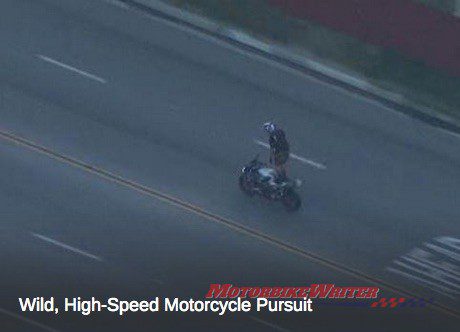A new video has emerged of motorcycle cop in a thrilling but highly dangerous motorcycle chase through the narrow streets and back alleys of Brazil.
The notorious police unit is called ROCAM which stands for Ronda Ostensiva com Apoio de Motocicletas in Portuguese and means “Ostensible Round with Motorcycle Support”.
The 7:36 minute video is a thrill a second, but like many similar ROCAM videos it has attracted a lot of negative comments about the dangers to the public of such police pursuits.
The video does not explain why police initiated the chase.
However, Brazil has high rates of violent crimes and is in the top 20 countries in the world for murder.
ROCAM is a group of select police deployed to fight drug and violent crime.
They work in groups of two and do specialised training every 15 days riding Yamaha and Honda motorcycles from 180cc up to the 647cc Honda Transalp.
The unit was formed in 1982 in Sao Paulo but there are now units all over Brazil.
Police pursuits
A leading police study has found the three most pressing issues for police reform around the world are use of force, policing of violence in families and high-speed pursuits.
A 2009 Australian Institute of Criminology study found deaths in custody at police stations are declining but “deaths in custody” as a result of high-speed pursuits were rising.
While less than 1% of police pursuits results in a fatal crash, 38% of the people killed are innocent bystanders.
It’s much worse in the USA where one person dies every day as a result of a police pursuit. Of those deaths, 1% are police, 55% suspects and 44% bystanders.
Most police procedures acknowledge the judgement of the officer at the scene to begin a pursuit.
However, continuation of the pursuit is then deferred to a senior officer at the station or headquarters.
They have to make a quick judgement based on the lethal risk to the community of the chase versus the lethal risk to the community of letting a serious offender escape.
This must be backed by information, not just mere suspicion.
Queensland police figures show only about 3% of pursuits involved imminent threat to life or a suspect escaping after a homicide.
Police have a duty to not only prevent and control crime, but more importantly, they have a duty to protect the community and that includes from their own reckless behaviour and judgement.



Restrictive practices
Despite criticism from police unions, most pursuit policies around the world, including the USA, are becoming more restrictive.
In many jurisdictions, pursuits are only allowed if there is a serious risk to public safety or in relation to a major crime involving death or injury.
However, there is an issue about making these pursuit policies public. Some say they should be public to show transparency while others believe it would give criminals clues on how to evade police.
Those who support pursuits point out that the number of people evading police is rising as a result of more restrictive pursuit policies, despite higher penalties for evading police.
Making the issue more complex is the degree of the pursuit.
Should there be an upper speed limit for police? Should police be allowed to break other road rules in the pursuit?
There have been incidences of police driving at more than 200km/h in a pursuit and on the road side of a major highway.
Another issue is whether police should be criminally culpable in the instance of a death resulting from a pursuit.
To a degree, technologies such as CCTV and number plate recognition cameras, negate the need for pursuits, anyway.



